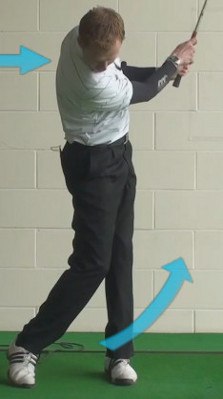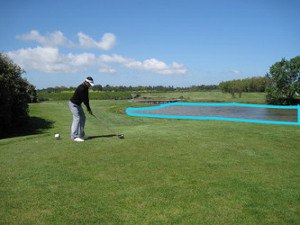
Golf is rife with knee-knocking challenges, but for sheer, panic-inducing terror, the shot over water has no equal. No one is immune, not even the pros – just ask anyone who's stood on the 12th tee at Augusta National or No. 17 at TPC Sawgrass wondering what club to hit.
If the world's greatest players get nervous when hitting over a hazard, what hope do the rest of us have? Plenty. Here are some handy tips for conquering this scary shot:
- Be target-oriented: Focus on where you want to hit the ball (the green or fairway) rather than where you don't want to hit it (the water). Preoccupation with danger inevitably lands you there, so think target, not trouble
- Take more club than you need: If water's in front of the green, wouldn't you rather be too long than too short? Make sure you've got plenty of club to carry all the way, even if it means going over the green. This gives you a margin for error in the event of a mishit.
- If possible, pick a favorite club: Stuck between two clubs. If there's one you tend to favor, hit that one. You'll have more confidence at address, and make better contact if history's an indication.
- Swing through to the finish: When we're anxious about results, we tend to lift the head or slow the swing too early. Visualize a full finish, posing as your ball lands safely on the green, then execute to bring the image to life.
A few deep breaths are always recommended when the nerves creep up. Make sure you're calm and steady before pulling the trigger.

Hitting Over Water – No Worries?
Water hazards are common in the game of golf. They are used for a variety of reasons, including to add challenge to the layout and to add visual appeal to the course. If you play a course which features a number of water hazards, you already know that they can cause your heart rate to increase a bit as you stand over the ball. A shot that you would normally have no trouble with may suddenly become rather difficult just because you have to hit over a bit of water. In this article, we are going to discuss the topic of water hazards. Specifically, we are going to talk about the mental approach you should use to give yourself the best possible chance to conquer these hazards time after time.
Let's get one point out of the way right off the top – you can't do anything about the water hazards that you are going to face on the links. You can't get rid of them, and in many cases, you can't go around them. From time to time, you are simply going to have no other choice but to play directly over the water. It is important to understand that water hazards are a part of the game, and your best bet is to rise to the challenge. Trying to 'run away' from this part of golf is a pointless exercise, because most courses you play will have at least one or two water hazards to deal with. The sooner you can embrace the challenge, the sooner you will be able to find success.
While it is important to embrace the challenge, it is also important to acknowledge that these are not 'normal' shots. In other words, you shouldn't just try to pretend that the water isn't there – because it is. Lying to yourself as a way to get around the mental challenge you are facing is never a good strategy. It is far better to confront the challenge with honesty. Are you going to be more nervous when hitting the ball over water? Probably – and that's okay. Professional golfers feel extra nerves when playing over ponds and creeks as well. In fact, some of the most famous holes in golf feature water hazards, as those are the holes most likely to force talented professionals into a mistake. There is nothing wrong with being a little nervous in such situations. The key is to play well in spite of your nerves.
All of the content below is written from the perspective of a right-handed golfer. If you happen to play left-handed, please take a moment to reverse the directions as necessary.

Three Types of Water Shots
There are a variety of different types of water shots you can encounter when on the golf course. Your approach to getting through these shots successfully will depend on what type of shot you are facing, the conditions at hand, and more. In this section, we are going to cover three common types of water shots you will face when playing golf, and how you should approach them to give yourself a good chance for a successful outcome.
- Forced carry over water. The first situation we are going to discuss is one where you have no choice but hit to the ball over a water hazard. A perfect example of this is a par three hole where the green is built on a peninsula out into the water. There is no 'safe' route to take in order to avoid the hazard – you just have to hit over the water and hope for the best. In some ways, these kinds of shots are easier than the shots where you have an option. You don't have to second guess your decision in this case, because there is no decision to make. Your shot selection has been forced by the design of the hole, so the only decision at hand is what club you are going to use. Once you've picked a club, all you can do is make your best swing and watch the ball fly. It is a good idea in this situation to build in some margin for error with regard to your club selection. For instance, if it is going to take a 145-yard shot to carry the water, you don't want to hit your 150-yard club – that would be cutting it too close. Pick a club that will allow you to carry the water even if you don't contact the ball perfectly on the sweet spot. Club selection isn't going to let your get away with a terrible swing, but it could save you on a slight miss-hit.
- Optional carry over water. This is where things might start to get tricky. A good example of this kind of hole is a par four where there is a pond guarding the front and right side of the green. If you are going to attack the green with your approach shot, you'll need to hit over the water. However, if you would like to avoid the water altogether, you may choose to play safely out to the left. You'll miss the green, but you should be able to chip or pitch over to the putting surface with your next shot. In this case, you do have a choice – which was not true in the previous scenario. The first thing you need to do here is set aside any concerns about what your playing partners will think if you layup to the side of the green. The only goal is to shoot the lowest score possible – it doesn't matter what path you take to make that happen. Once you set peer pressure to the side, the next thing to consider is the likelihood that you will be able to make it over the water. All golf shots contain some degree of risk, so it isn't smart to layup automatically anytime water is in the picture. Rather, you need to decide in each individual situation if the risk is worth the reward. If it's only 100-yards to get over the water, and you have a good lie, you probably have a good chance to make it. On the other hand, if it's 200-yards to get over, and your ball is sitting down in the rough, there is very little hope. Make an honest assessment of the situation and proceed with the decision that gives you the most confidence.
- Shot played to the side of a water hazard. You might be surprised to learn that this situation can be even more difficult than playing directly over a water hazard. When you are playing alongside a hazard, you don't have the option of simply hitting the ball far enough to avoid trouble. You know you won't hit the shot far enough to stay dry, so the only choice is to keep your shot online. That kind of pressure is hard to ignore while you swing, and you might wind up hitting more balls into the drink in this situation than any other. On this kind of hole, the water may run down the side of the fairway from tee to green, meaning that a miss on the water side is guaranteed to be penalized. A big part of deciding how to proceed here is going to come down to the location of the water compared to your typical ball flight. If the water is on the right and you hit a fade, it's not hard to imagine a bad outcome. In such a situation, you will want to be conservative, and consider hitting less club to improve your control. When the water is on the opposite side from your ball flight pattern – on the left for a player who hits a fade – you can swing with more confidence, knowing it's unlikely you'll miss in the wet direction.
As is always the case in golf, decision making is going to play a big role in your success or failure when you encounter shots that have to deal with water hazards. If you fail to make the right choice, you are likely to pay the price on your scorecard. Think each shot through carefully, and proceed with the option that you feel is most likely to lead to a good result. You won't make the right choice in every instance, but simply paying attention to your thought process should help you find better outcomes in the long run.

The Basics of a Good Mindset
You are going to need to have the right attitude when you step up to the ball with water somewhere off in the distance. Unfortunately, it is easy to get yourself into a negative mindset when playing these kinds of shots, and that is exactly what most amateur golfers do. Rather than thinking about the great shot they could hit, the average player pictures the ball falling into the pond or the creek. If you visualize those negative results, the scene played out in your mind is going to play out in real life more times than not.
It is key to find a way to turn your thinking in a positive direction on these intimidating shots. The tips below may be of some help in this area.
- Pick out a specific landing spot. To help take your mind off of the water, you'll want to pick a specific landing spot that you are aiming for with your shot. Of course, you should be doing this on every shot you hit throughout the round, but it is particularly important when hitting a shot where water is involved. Once you have a landing spot in mind, you can then pick a club, a ball flight, and get ready to make a swing. This kind of planning is going to give some purpose to your swing. The last thing you want to do is simply make a swing which is trying to just 'avoid the water'. That is a negative line of thinking, and it isn't going to help you play good golf. Make it your goal to hit your very specific target, and then align everything you do with that goal.
- Take some of the fear away. At the end of the day, this is just golf, and it is a game you play for fun. So what if you hit the ball into the water? Is having to add a penalty stroke to your score really that big of a deal? Probably not. You'd rather avoid the water, obviously, but hitting a golf ball into a pond isn't something to get all worked up about. In fact, hitting into the water usually won't even do that much damage to your scorecard, as it is just a one stroke penalty. Depending on the color of the stakes – either red or yellow – you will have some specific options for taking your drop and moving on. By realizing that hitting a golf ball into a hazard isn't a big deal in the real world, you may be able to relax and focus on hitting a good shot.
- Think about other shots. Imagine that you are facing a 150-yard shot over water to the green. In order to build up your confidence, think back to successful shots you have hit from a similar distance earlier in the round. If those shots would have cleared the water safely, there is no reason to think you can't do it again. One of the best ways to put yourself in a positive frame of mind on the golf course is by calling on positive memories. Even if you are a beginning golfer, it's likely you have hit a few good shots along the way. Remember those good shots, use them for encouragement, and step over the ball with your mind in a good place to be successful.
If you are used to thinking negatively when getting ready to deal with a shot over water, it may take some time to turn your thinking around. That's okay. The key here is to think as positively as you can on each shot, and to improve with every opportunity. Pretty soon, you will find that you feel far more comfortable when playing shots near water hazards, and your game will be better as a result.






